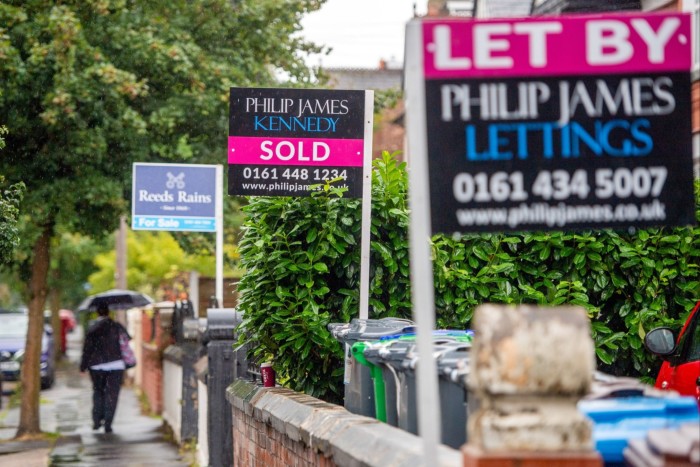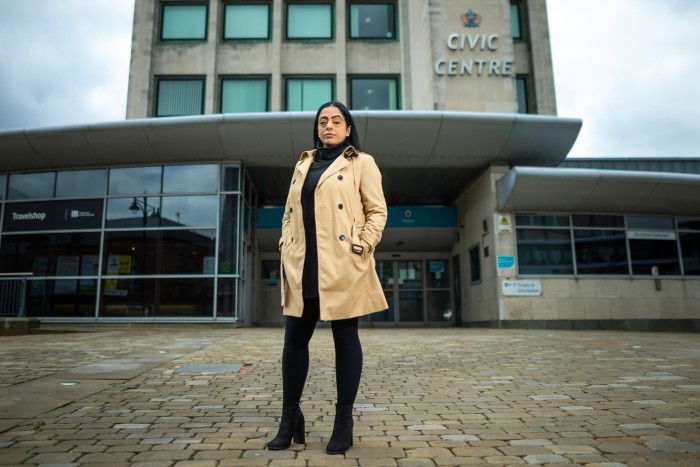When bailiffs threatened to change her locks out of the blue, Elizabeth’s first thought was to ring her landlord for help.
But it turned out the landlord had not paid his mortgage so the single mother of three was evicted and placed in temporary accommodation by the local council in Oldham, just outside Manchester.
“It’s stressful” not having a permanent home, the 49-year-old said, adding that despite the temporary placement being plagued with flies and bad smells, it was “better than being on the streets”.
Elizabeth’s story is becoming increasingly common as the UK’s lack of affordable housing collides with growing demand, rising living costs and the tighter margins faced by landlords.
Rents in the country are at their highest since the Office for National Statistics began recording them in 2016, following years of stagnant housebuilding and growing demand.
The increase has left areas that did not have a significant problem with homelessness suddenly confronting soaring numbers of people with nowhere to live.
Oldham has been a relatively affordable place to rent historically but its rate of homelessness is now nearly twice the national average, with an 80 per cent year-on-year increase between January and April, and a similar rise in the number of children living in emergency housing.
“Unfortunately, the trends aren’t surprising and reflect that the overall housing crisis has affected all parts of the country, particularly places that aren’t traditionally thought of in this way,” said Jasmine Basran, policy and public affairs manager at the homelessness charity Crisis, adding that a chronic lack of social housing had removed a crucial safety net.
The government’s latest homelessness statistics reveal the growing numbers at the sharp end of the crisis; the number of children living in temporary accommodation was up 10 per cent year on year in the first three months of this year.
Experts said Britain’s shortage of housing was at the heart of the crisis. “It’s hugely problematic,” said Ben Beadle, chief executive of the National Residential Landlords Association. The answer, he added, was to “sort out the lack of homes”.
The shortage of rental accommodation has been exacerbated by the challenges facing landlords, who have been hit with rising interest rates and higher mortgage costs over the past year, making buy-to-let investments less attractive.
“Typically, people who are homeless, or at risk of homelessness, do look for some affordable housing within the private rented sector,” said Basran of Crisis. “But we’re seeing more competition at that end because people’s incomes are squeezed — and landlords are looking at their options and struggling, to be frank.”
A report by the real estate consultancy Savills earlier this year found that net profits for investors in the private rented sector had fallen to their lowest levels since 2007, driven by interest rate rises and taxation changes.
Beadle said a growing number of landlords were now in an “invidious position” financially. Even taking the mortgage rate rises of the last year “out of the equation”, returns had been “pretty marginal for quite a period of time”, he said.
While there were no signs yet of an exodus of landlords from the market, anecdotally “more people are selling than buying and more people are saying that they are going to sell than invest”, he added. “I’ve just spoken to a chap whose mortgage is going from £800 to £1,500 — he’s not going to be able to pass on a £700 rent increase . . . he might have to sell.”
Such decisions are feeding into destitution statistics. In the first quarter of 2023, the number of households becoming homeless as a result of landlords either selling up or raising rent jumped 27 per cent from the previous year, according to government data.
“No fault” bailiff evictions under Section 21 of the Housing Act, in which tenants such as Elizabeth are forcibly ejected despite not breaching their tenancies, also rocketed 41 per cent during the same period.
Evictions were banned during the coronavirus pandemic, but since 2021 the courts in England and Wales have gradually been clearing backlogs in applications.

For families priced out of renting entirely, local authorities step in to provide temporary accommodation, sometimes of very poor quality.
Dr Laura Neilson, chief executive of the Greater Manchester homelessness charity Shared Health Foundation, said local authorities often avoided placing overly stringent standards on temporary housing, in case it led to “lots of landlords selling up”.
Experts say the 2016 freezing of Local Housing Allowance, the benefit intended to top up the rents of poorer households living in the private rental sector, has exacerbated the problem.
An analysis by the Institute for Fiscal Studies think-tank, using data from online estate agency Zoopla, found that across Britain just 5 per cent of private rents advertised in the first quarter of 2023 could be covered using LHA.
In Manchester booming demand for housing has caused rents to outstrip LHA rates, leaving it with a severe family homelessness crisis for some years. The median rent for a three-bed house in the city rose 13 per cent between 2022 and 2023, according to the ONS, while homelessness due to rent rises or landlord sales rose 500 per cent year on year in the first quarter of this year.
Louise Emmott, of city centre property agency Kingsdene, said that since the pandemic a surge in people living in Manchester and periodically commuting to London had added to demand. She said that “a big lack of supply in student accommodation” was adding to the pressure.
In Oldham, Elizabeth said that despite the smell in her temporary placement, she and her children “closed the windows for two weeks” to try and get rid of the many flies that kept appearing. “We didn’t know where they were coming from,” she said.
She eventually discovered that a toilet had been blocked for weeks before they moved in.
Arooj Shah, leader of Oldham council, apologised for the problems Elizabeth was facing.
“We’re seeing really worrying rises in the number of Oldham families requiring temporary accommodation”, she said, with figures having “more than doubled in the last three years”.
Shah put the increase down to “the failure of the private rented sector”.

The Department for Levelling Up, Housing and Communities said it had provided £2bn to councils over three years to help combat homelessness.
“Councils have a duty to ensure no family is left without a roof over its head, and government funding can be used to help people find a new home, work with landlords to prevent evictions, or to pay for temporary accommodation,” it said.











